- Joined
- Feb 2, 2011
- Messages
- 2,359
NEW RELEASES FOR JULY 2024
THE EIGHTEENTH CENTURY COLLECTION
THE AMERICAN WAR OF INDEPENDENCE 1775 – 1783
THE BATTLE OF COWPENS, JANUARY 17[SUP]th[/SUP], 1781.
THE 7[SUP]th[/SUP] REGIMENT OF FOOT (ROYAL FUSILIERS.)
The Battle of Cowpens was an engagement during the American Revolutionary War fought on January 17[SUP]th[/SUP] 1781, near the town of Cowpens, South Carolina, between American forces under Brigadier General Daniel Morgan, and British forces under Lieutenant Colonel Banastre Tarleton, as part of the campaign in the Carolinas.
The battle was a turning point in the American reconquest of South Carolina from the British.
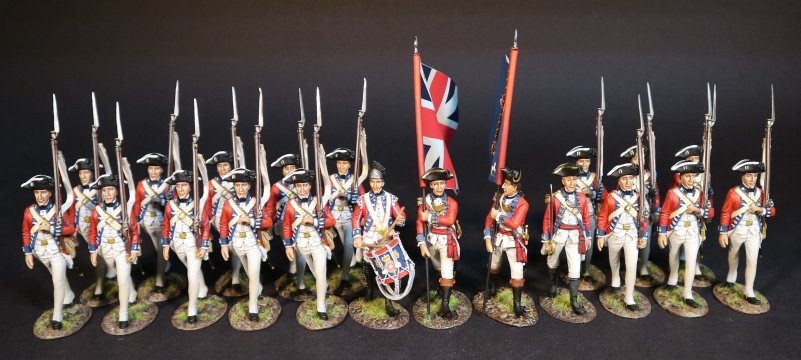
The Royal Fusiliers (city of London Regiment) was a line infantry regiment of the British Army which has been in continuous existence for 283 years. It was known as the 7[SUP]th[/SUP] Regiment of Foot until the Childers Reforms in 1881.
In 1747 the regiment was known as the Royal English Fuziliers and was given the precedence of 7[SUP]th[/SUP] in the Infantry of the Line. On 1[SUP]st[/SUP] July 1751 it was redesignated as the 7[SUP]th[/SUP] Regiment of Foot (Royal Fusiliers).
When county titles were added in August 1782 the subtitle (Derbyshire) was added, but this was never used and was later given to a different regiment.
The Royal Fusiliers were sent to Canada in April 1773. The regiment was broken up into detachments that served at Montreal, Quebec, Fort Chambly and Fort St. Johns. In the face of the American invasion of Canada in 1775/76, the 80 man garrison of Fort Chambly attempted to resist a 400 man Rebel force but ultimately had to surrender, losing its regimental colours as a result. The bulk of the regiment was captured when St. John’s fell.
A 70 man detachment under the command of Captain Humphrey Owens assisted with the Battle of Quebec in December 1775.
The men taken prisoner during the defence of Canada were exchanged in British held New York city in December 1776. Here the regiment was rebuilt and garrisoned New York and New Jersey. In October 1777, the 7[SUP]th[/SUP] participated in the successful assaults on Fort Clinton and Fort Montgomery and the destruction of enemy stores at Continental Village. In late November, 1777 the regiment reinforced the garrison of Philadelphia. During the British evacuation back to New York city, the regiment participated in a diversionary raid in the days leading up to the Battle of Monmouth in June 1778.
In April 1780, the Royal Fusiliers took part in the capture of Charleston. Once Charleston fell, the regiment helped garrison the city. Three companies were sent to Ninety-Six to assist with the training of Loyalist militia companies. An 80 man detachment was also sent to Camden, South Carolina to help build that town’s defences. The detachments were recalled to Charleston for refitting in late August 1780.
The 7[SUP]th[/SUP], mounted on horses, along with the two regiments of Loyalist militia, cleared the region north of Georgetown, South Carolina of partisans while en route. The Royal Fusiliers turned the horses over to Lieutenant Colonel Banastre Tarleton’s British Legion upon uniting with Cornwallis in late September and then served as the Army’s rearguard.
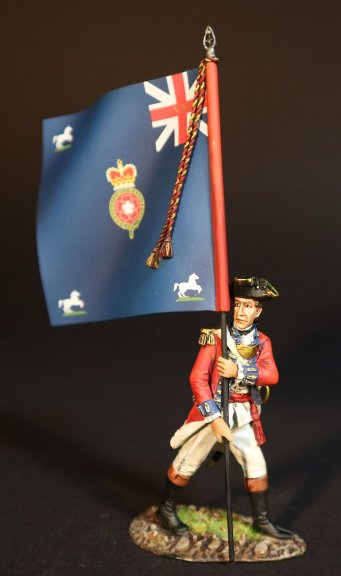
CW7FL-02
THE AMERICAN WAR OF INDEPENDENCE 1775-1783,
THE BATTLE OF COWPENS, JANUARY 17[SUP]th[/SUP] 1781,
7[SUP]th[/SUP] REGIMENT OF FOOT (ROYAL FUSILIERS.)
STANDARD BEARER
Between October 1780 and early 1781, the regiment, having lost about one third of its officers and men to sickness and disease, protected the communication and supply lines between Camden and Winnsboro, South Carolina. On 7[SUP]th[/SUP] January, 1781, a contingent of 171 men from the Royal Fusiliers was detached from Cornwallis’s Army and fought under the command of Tarleton at the Battle of Cowpens in January 1781.
The Royal Fusiliers were on the left of the line of battle: Tarleton was defeated and the regiment’s colours were once again captured, and stored in the baggage wagons.
A 19 man detachment from the regiment fought through North Carolina participating in the Battle of Guilford Court House in March 1781 and ultimately the siege of Yorktown, where it served with the regiment’s Light Infantry Company. There was another detachment, composed largely of men recovered from the hospitals and recruits, which remained in the South under the command of Lt. Col. Alured Clarke. These men remained in garrison in Charleston, until they were transferred to Savannah, Georgia in December 1781.
The regiment returned to England in 1783.
CONTINENTAL LINE INFANTRY
HOWARD’S MARYLAND CONTINENTALS
The main core of Morgan’s flying Army was a battalion of veteran Continentals. Three companies of the Maryland Line, and one company from Delaware. These were highly trained and disciplined, and formed the main line commanded by John Eager Howard. They were the best troops to engage in prolonged close combat with British regulars.
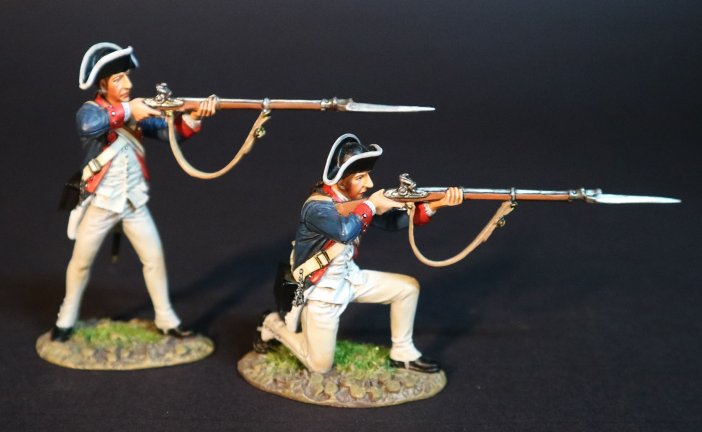
CWML-05
THE AMERICAN WAR OF INDEPENDENCE 1775 – 1783
THE BATTLE OF COWPENS, JANUARY 17[SUP]th[/SUP], 1781.
AMERICAN CONTINENTAL LINE INFANTRY,
HOWARD’S MARYLAND CONTINENTALS
The three Maryland companies at the Battle of Cowpens were survivors from several ravaged regiments.
The First Company (Captain Richard Anderson) included survivors of the 1[SUP]st[/SUP] and 7[SUP]th[/SUP] Maryland.
The Second Company (Captain Henry Dobson) was formed from the 2[SUP]nd[/SUP], 4[SUP]th[/SUP] and 6[SUP]th[/SUP] Maryland.
The Third Company (Lieutenant Nicholas Mangers) included men from the old 3[SUP]rd[/SUP] and 5[SUP]th[/SUP] Maryland.
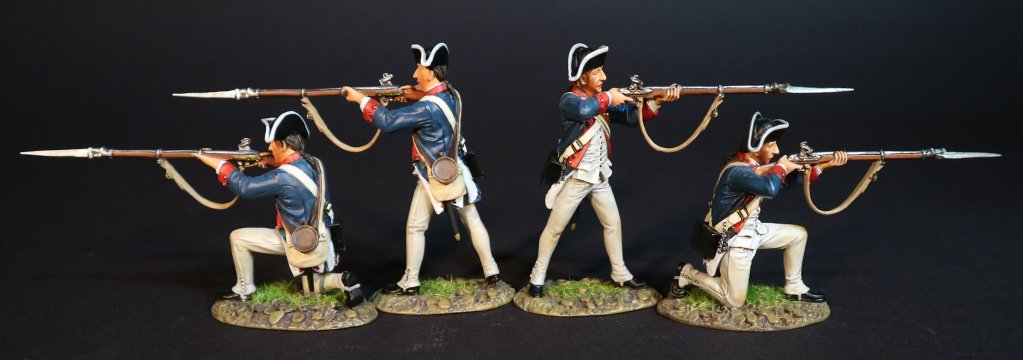
CWML-05N
THE AMERICAN WAR OF INDEPENDENCE 1775 – 1783
THE BATTLE OF COWPENS, JANUARY 17[SUP]th[/SUP], 1781.
AMERICAN CONTINENTAL LINE INFANTRY,
HOWARD’S MARYLAND CONTINENTALS
Please note these are repaints of the CWDEL-03
EIGHTEENTH CENTURY ARTILLERY LIMBER
Limbers were used when transporting cannon by horse over long distances. Attached to the gun carriage, it transformed it from two wheels to a four wheeled vehicle.

**Please remember the horses will be sold separately, as well as the artillery piece.**
HORSES WILL BE RESTOCKED IN OCTOBER
In the Eighteenth Century artillery limbers played a crucial role in the movement and deployment of field artillery.
The limber was a two wheeled cart specifically designed to support the trail of an artillery piece or the stock of a field carriage, such as a caisson or travelling forge.
The artillery piece when needed to be towed was raised over the limber and then lowered with a pintle fitting into a hole in the trail.
Horses or other draft animals were harnessed in a single file to haul the limber.
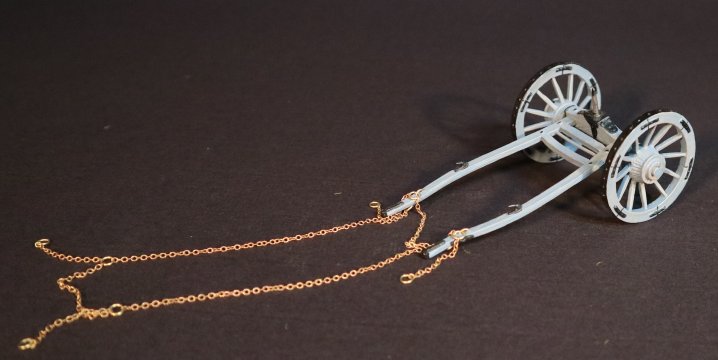
BAL-16
THE EIGHTEENTH CENTURY,
THE BRITISH ARTILLERY,
ARTILLERY LIMBER
THE SEVEN YEARS WAR
THE THIRD CARNATIC WAR 1756-1763
THE BATTLE OF WANDEWASH, 22[SUP]nd[/SUP] JANUARY 1760
THE BRITISH ARMY
The Battle of Wandewash was a confrontation between the French under the command of The Comte de Lally, and the British Sir Eyre Coote. It was the decisive battle in the Anglo French struggle in southern India during the Seven Years War.
Lally, cut off from sea support by the withdrawal of Admiral d’Aché’s fleet and hampered by a lack of funds and by dissensions among his troops, tried to recover the fort of Wandiwash near Pondicherry.
There he was attacked and routed by Coote, with about 1,700 British troops against about 2,000 French. Lally’s best general, the marquis de Bussy, was captured. The French were thereafter confined to Pondicherry, which surrendered on Jan. 16, 1761, after much privation. Lally was later imprisoned and executed, after a trial in Paris, for alleged treason
The following two British regular units served in India and were present at the battle of Wandewash. It should be noted however that it was rare for these units to serve as complete battalions, and that they were generally broken up into detachments.
The British 79[SUP]th[/SUP] Regiment of Foot, was raised in November 1757, originally as the 64[SUP]th[/SUP] with drafts taken from the 4[SUP]th[/SUP], 8[SUP]th[/SUP] and 24[SUP]th[/SUP] foot, but was later re-numbered during the shake up after various second Battalions were taken into the line.
The regiment was to mainly see service in India from 1758, and was disbanded in 1764.
Its commander was Major Brereton
The 84[SUP]th[/SUP] (Coote’s) Regiment was raised in January 1759, specifically for service in India.
The regiment was ordered home to be disbanded in 1764, but was instead reduced in India and most of the personnel were to enter the East India Company service.
Initially the Madras European Regiment were not conventionally organized infantry battalions. Their organization, or what there was of it, resembled that of the marines, serving in effect as a pool from which more or less ad hoc companies and detachments could be formed for specific tasks.As long as the East India Company’s need was for purely defensive forces, tasked with watching over its factories and escorting merchants and officials this informal organization was adequate.
BRITISH SEPOYS
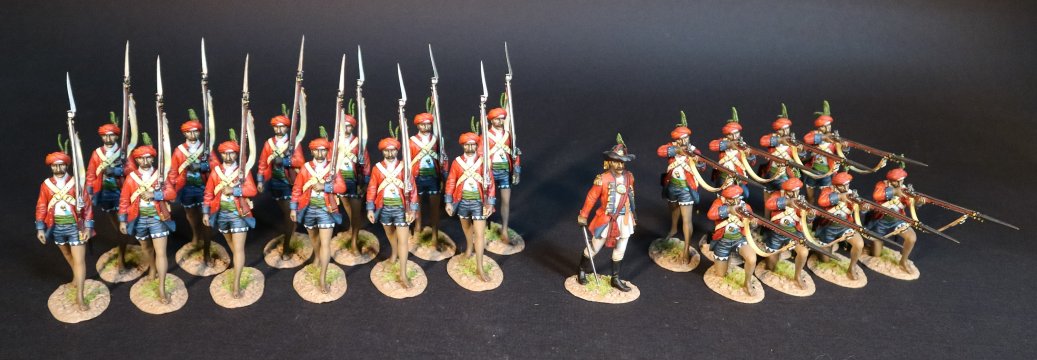
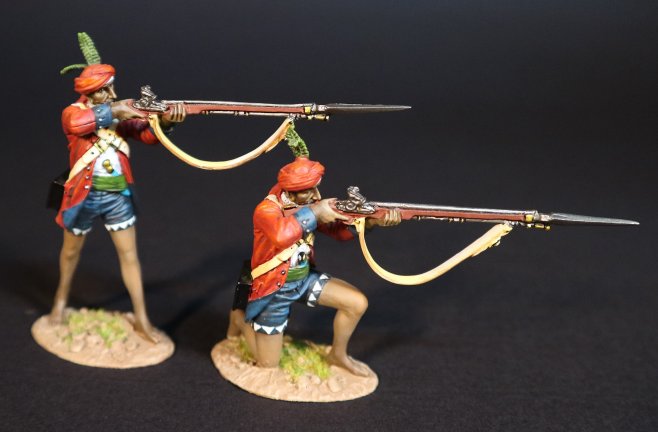
WBS-03
THE SEVEN YEARS WAR,
THE THIRD CARNATIC WAR 1756-1763,
THE BATTLE OF WANDEWASH, 22[SUP]nd[/SUP] JANUARY 1760,
THE BRITISH ARMY,
BRITISH SEPOYS
At the outset native units were in effect mercenary bands, recruited, equipped and led by their own officers, and generally referred to as Peons. By 1750 the East India Company were training and equipping their native soldiers in European fashion, and distinguishing them from the earlier rabble by using the term Sepoys instead.
In Bengal the first permanent unit of Sepoys was formed by Clive in early 1757. Clive dressed the Bengal Sepoys in red which was also adopted by the Madras units in 1759.
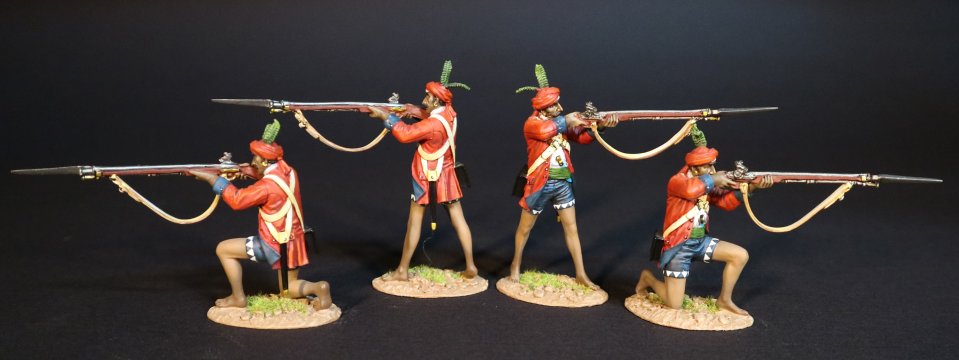
WBS-03N
THE SEVEN YEARS WAR,
THE THIRD CARNATIC WAR 1756-1763,
THE BATTLE OF WANDEWASH, 22[SUP]nd[/SUP] JANUARY 1760,
THE BRITISH ARMY,
BRITISH SEPOYS
** PLEASE CONTACT YOUR LOCAL DEALER FOR FURTHER INFORMATION **
THE EIGHTEENTH CENTURY COLLECTION
THE AMERICAN WAR OF INDEPENDENCE 1775 – 1783
THE BATTLE OF COWPENS, JANUARY 17[SUP]th[/SUP], 1781.
THE 7[SUP]th[/SUP] REGIMENT OF FOOT (ROYAL FUSILIERS.)
The Battle of Cowpens was an engagement during the American Revolutionary War fought on January 17[SUP]th[/SUP] 1781, near the town of Cowpens, South Carolina, between American forces under Brigadier General Daniel Morgan, and British forces under Lieutenant Colonel Banastre Tarleton, as part of the campaign in the Carolinas.
The battle was a turning point in the American reconquest of South Carolina from the British.

The Royal Fusiliers (city of London Regiment) was a line infantry regiment of the British Army which has been in continuous existence for 283 years. It was known as the 7[SUP]th[/SUP] Regiment of Foot until the Childers Reforms in 1881.
In 1747 the regiment was known as the Royal English Fuziliers and was given the precedence of 7[SUP]th[/SUP] in the Infantry of the Line. On 1[SUP]st[/SUP] July 1751 it was redesignated as the 7[SUP]th[/SUP] Regiment of Foot (Royal Fusiliers).
When county titles were added in August 1782 the subtitle (Derbyshire) was added, but this was never used and was later given to a different regiment.
The Royal Fusiliers were sent to Canada in April 1773. The regiment was broken up into detachments that served at Montreal, Quebec, Fort Chambly and Fort St. Johns. In the face of the American invasion of Canada in 1775/76, the 80 man garrison of Fort Chambly attempted to resist a 400 man Rebel force but ultimately had to surrender, losing its regimental colours as a result. The bulk of the regiment was captured when St. John’s fell.
A 70 man detachment under the command of Captain Humphrey Owens assisted with the Battle of Quebec in December 1775.
The men taken prisoner during the defence of Canada were exchanged in British held New York city in December 1776. Here the regiment was rebuilt and garrisoned New York and New Jersey. In October 1777, the 7[SUP]th[/SUP] participated in the successful assaults on Fort Clinton and Fort Montgomery and the destruction of enemy stores at Continental Village. In late November, 1777 the regiment reinforced the garrison of Philadelphia. During the British evacuation back to New York city, the regiment participated in a diversionary raid in the days leading up to the Battle of Monmouth in June 1778.
In April 1780, the Royal Fusiliers took part in the capture of Charleston. Once Charleston fell, the regiment helped garrison the city. Three companies were sent to Ninety-Six to assist with the training of Loyalist militia companies. An 80 man detachment was also sent to Camden, South Carolina to help build that town’s defences. The detachments were recalled to Charleston for refitting in late August 1780.
The 7[SUP]th[/SUP], mounted on horses, along with the two regiments of Loyalist militia, cleared the region north of Georgetown, South Carolina of partisans while en route. The Royal Fusiliers turned the horses over to Lieutenant Colonel Banastre Tarleton’s British Legion upon uniting with Cornwallis in late September and then served as the Army’s rearguard.

CW7FL-02
THE AMERICAN WAR OF INDEPENDENCE 1775-1783,
THE BATTLE OF COWPENS, JANUARY 17[SUP]th[/SUP] 1781,
7[SUP]th[/SUP] REGIMENT OF FOOT (ROYAL FUSILIERS.)
STANDARD BEARER
Between October 1780 and early 1781, the regiment, having lost about one third of its officers and men to sickness and disease, protected the communication and supply lines between Camden and Winnsboro, South Carolina. On 7[SUP]th[/SUP] January, 1781, a contingent of 171 men from the Royal Fusiliers was detached from Cornwallis’s Army and fought under the command of Tarleton at the Battle of Cowpens in January 1781.
The Royal Fusiliers were on the left of the line of battle: Tarleton was defeated and the regiment’s colours were once again captured, and stored in the baggage wagons.
A 19 man detachment from the regiment fought through North Carolina participating in the Battle of Guilford Court House in March 1781 and ultimately the siege of Yorktown, where it served with the regiment’s Light Infantry Company. There was another detachment, composed largely of men recovered from the hospitals and recruits, which remained in the South under the command of Lt. Col. Alured Clarke. These men remained in garrison in Charleston, until they were transferred to Savannah, Georgia in December 1781.
The regiment returned to England in 1783.
CONTINENTAL LINE INFANTRY
HOWARD’S MARYLAND CONTINENTALS
The main core of Morgan’s flying Army was a battalion of veteran Continentals. Three companies of the Maryland Line, and one company from Delaware. These were highly trained and disciplined, and formed the main line commanded by John Eager Howard. They were the best troops to engage in prolonged close combat with British regulars.

CWML-05
THE AMERICAN WAR OF INDEPENDENCE 1775 – 1783
THE BATTLE OF COWPENS, JANUARY 17[SUP]th[/SUP], 1781.
AMERICAN CONTINENTAL LINE INFANTRY,
HOWARD’S MARYLAND CONTINENTALS
The three Maryland companies at the Battle of Cowpens were survivors from several ravaged regiments.
The First Company (Captain Richard Anderson) included survivors of the 1[SUP]st[/SUP] and 7[SUP]th[/SUP] Maryland.
The Second Company (Captain Henry Dobson) was formed from the 2[SUP]nd[/SUP], 4[SUP]th[/SUP] and 6[SUP]th[/SUP] Maryland.
The Third Company (Lieutenant Nicholas Mangers) included men from the old 3[SUP]rd[/SUP] and 5[SUP]th[/SUP] Maryland.

CWML-05N
THE AMERICAN WAR OF INDEPENDENCE 1775 – 1783
THE BATTLE OF COWPENS, JANUARY 17[SUP]th[/SUP], 1781.
AMERICAN CONTINENTAL LINE INFANTRY,
HOWARD’S MARYLAND CONTINENTALS
Please note these are repaints of the CWDEL-03
EIGHTEENTH CENTURY ARTILLERY LIMBER
Limbers were used when transporting cannon by horse over long distances. Attached to the gun carriage, it transformed it from two wheels to a four wheeled vehicle.

**Please remember the horses will be sold separately, as well as the artillery piece.**
HORSES WILL BE RESTOCKED IN OCTOBER
In the Eighteenth Century artillery limbers played a crucial role in the movement and deployment of field artillery.
The limber was a two wheeled cart specifically designed to support the trail of an artillery piece or the stock of a field carriage, such as a caisson or travelling forge.
The artillery piece when needed to be towed was raised over the limber and then lowered with a pintle fitting into a hole in the trail.
Horses or other draft animals were harnessed in a single file to haul the limber.

BAL-16
THE EIGHTEENTH CENTURY,
THE BRITISH ARTILLERY,
ARTILLERY LIMBER
THE SEVEN YEARS WAR
THE THIRD CARNATIC WAR 1756-1763
THE BATTLE OF WANDEWASH, 22[SUP]nd[/SUP] JANUARY 1760
THE BRITISH ARMY
The Battle of Wandewash was a confrontation between the French under the command of The Comte de Lally, and the British Sir Eyre Coote. It was the decisive battle in the Anglo French struggle in southern India during the Seven Years War.
Lally, cut off from sea support by the withdrawal of Admiral d’Aché’s fleet and hampered by a lack of funds and by dissensions among his troops, tried to recover the fort of Wandiwash near Pondicherry.
There he was attacked and routed by Coote, with about 1,700 British troops against about 2,000 French. Lally’s best general, the marquis de Bussy, was captured. The French were thereafter confined to Pondicherry, which surrendered on Jan. 16, 1761, after much privation. Lally was later imprisoned and executed, after a trial in Paris, for alleged treason
The following two British regular units served in India and were present at the battle of Wandewash. It should be noted however that it was rare for these units to serve as complete battalions, and that they were generally broken up into detachments.
The British 79[SUP]th[/SUP] Regiment of Foot, was raised in November 1757, originally as the 64[SUP]th[/SUP] with drafts taken from the 4[SUP]th[/SUP], 8[SUP]th[/SUP] and 24[SUP]th[/SUP] foot, but was later re-numbered during the shake up after various second Battalions were taken into the line.
The regiment was to mainly see service in India from 1758, and was disbanded in 1764.
Its commander was Major Brereton
The 84[SUP]th[/SUP] (Coote’s) Regiment was raised in January 1759, specifically for service in India.
The regiment was ordered home to be disbanded in 1764, but was instead reduced in India and most of the personnel were to enter the East India Company service.
Initially the Madras European Regiment were not conventionally organized infantry battalions. Their organization, or what there was of it, resembled that of the marines, serving in effect as a pool from which more or less ad hoc companies and detachments could be formed for specific tasks.As long as the East India Company’s need was for purely defensive forces, tasked with watching over its factories and escorting merchants and officials this informal organization was adequate.
BRITISH SEPOYS


WBS-03
THE SEVEN YEARS WAR,
THE THIRD CARNATIC WAR 1756-1763,
THE BATTLE OF WANDEWASH, 22[SUP]nd[/SUP] JANUARY 1760,
THE BRITISH ARMY,
BRITISH SEPOYS
At the outset native units were in effect mercenary bands, recruited, equipped and led by their own officers, and generally referred to as Peons. By 1750 the East India Company were training and equipping their native soldiers in European fashion, and distinguishing them from the earlier rabble by using the term Sepoys instead.
In Bengal the first permanent unit of Sepoys was formed by Clive in early 1757. Clive dressed the Bengal Sepoys in red which was also adopted by the Madras units in 1759.

WBS-03N
THE SEVEN YEARS WAR,
THE THIRD CARNATIC WAR 1756-1763,
THE BATTLE OF WANDEWASH, 22[SUP]nd[/SUP] JANUARY 1760,
THE BRITISH ARMY,
BRITISH SEPOYS
** PLEASE CONTACT YOUR LOCAL DEALER FOR FURTHER INFORMATION **

